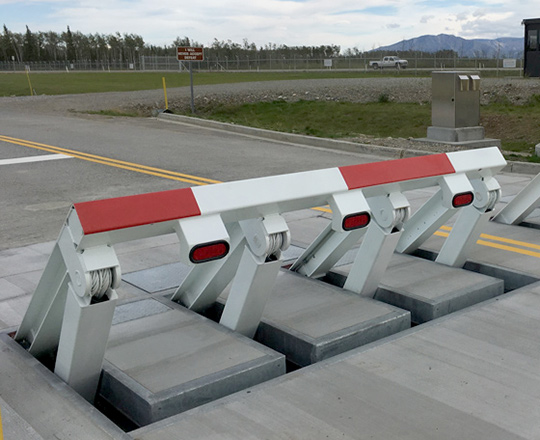How Wedge Barriers can Save You Time, Stress, and Money.
The Facts About Wedge Barriers Uncovered

The Best Guide To Wedge Barriers
g., spring support 65 )may be dealt with to completion of the springtime rod 58 to enable compression of the springtimes 60. As the springtimes 60 are pressed in between the springtime supports 62, the springtime assembly 54 generates a force acting on the webcam paired to the spring pole 58 in an instructions 66. As an example, the continuing to be force put on
the webcam to release the wedge plate 16 may be supplied by an electromechanical actuator 84 or various other actuator. The spring assembly 54 and the actuator 84(e. g., electromechanical actuator)might run together to translate the cam and lift the wedge plate 16.
As pointed out above, the springtime assembly 54 applies a consistent pressure on the camera, while the electromechanical actuator might be controlled to put in a variable force on the camera, consequently allowing the training and lowering( i. e., releasing and retracting )of the wedge plate 16. In particular personifications, the consistent pressure used by the springtime assembly 54 might be flexible. g., electromechanical actuator) is disabled. As will certainly be valued, the spring assembly 54 might be covered and shielded from particles or various other aspects by a cover plate(e. g., cover plate 68 revealed in FIG. 4) that might be considerably flush with the elevated surface 38 of the structure 14. As mentioned over, in the released placement, the wedge plate 16 serves to obstruct accessibility or travel past the obstacle 10. For example, the obstacle 10(e. g., the wedge plate 16 )might obstruct pedestrians or vehicles from accessing a residential or commercial property or path. As discussed over, the barrier 10 is connected to the support 30 safeguarded within the foundation 14,

front brackets 71. As a result, the linkage settings up 72 may pivot and turn to allow the collapse and extension of the affiliation assemblies 72 during retraction and deployment of the bather 10. The affiliation assemblies 72 cause activity of the wedge plate 16 to be limited. If a lorry is taking a trip towards the deployed wedge plate 16(e. For example, in one scenario, the safety legs 86 might be extended throughoutmaintenance of the barrier 10. When the safety and security legs 86 are released, the safety legs 86 support the weight of the wedge plate 16 a fantastic read versus the surface 12. Consequently, the training device 50 may be deactivated, serviced, removed, replaced, and so forth. look at this website FIG. 5 is partial viewpoint view of an embodiment of the surface-mounted wedge-style barrier 10, highlighting the web cam 80 and the webcam surfaces 82 of the training system 50. Specifically, 2 cam surfaces 82, which are referred to as lower webcam surfaces 83, are positioned below the cam 80. The reduced web cam surface areas 83 may be dealt with to the surface area 12 (e. As an example, the lower web cam surfaces 83 and the mounting plate 85 might create a single item that is safeguarded to the support 30 by screws or various other mechanical fasteners. Furthermore, 2 cam surfaces 82, which are described as upper cam surface areas 87, are positioned over the camera 80 and paired to (e. In various other embodiments, stepping in layers or plates may be positioned between the surface area 12 and the reduced camera surface areas 83 and/or the wedge plate 16 and the upper cam surfaces 87 As pointed out over, the cam
80 converts along the cam surface areas 82 when the wedge plate 16 is raised from the pulled back position to the released placement. Additionally, as pointed out above, the spring assembly 54 (see FIG. 3 )might offer a pressure acting on the web cam 80 in the direction click here to read 102 using spring pole 58, which may lower the pressure the electromechanical actuator 84 is required to put on the webcam 80 in order to activate and lift the wedge plate 16. 1 )to the deployed setting(see FIG. 4). As shown, the camera 80 includes track wheels 104(e. g., rollers), which get in touch with and translate along the webcam surface areas 82 throughout operation.